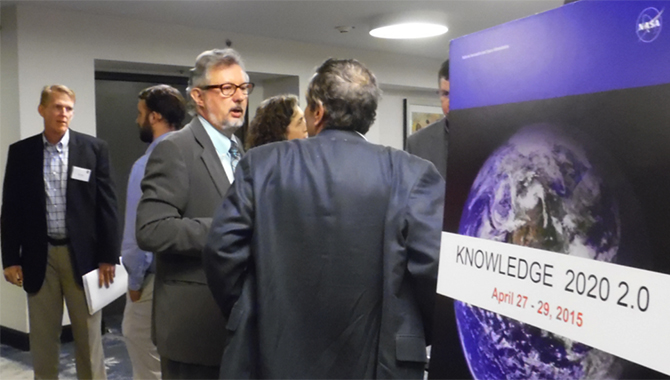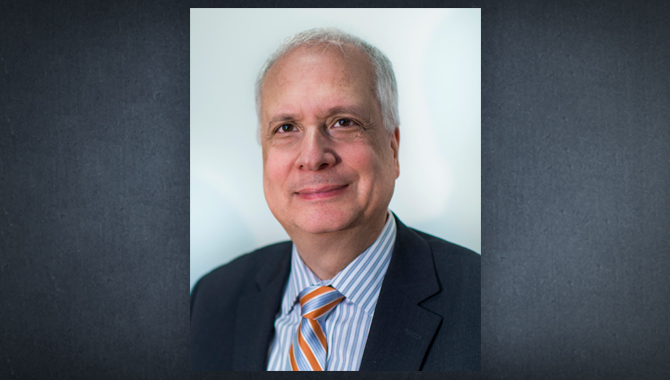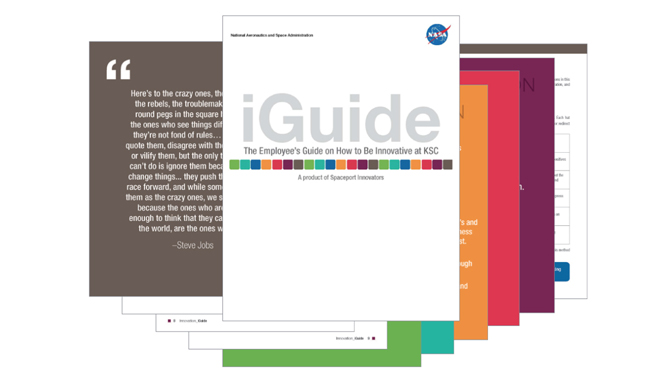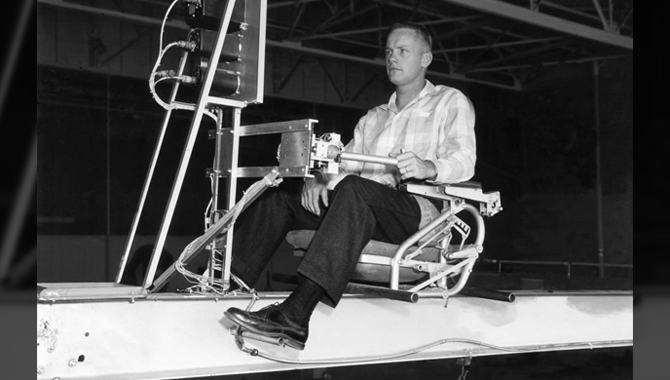
April 2015, Dan Ranta (far left), former Director of Knowledge Sharing, ConocoPhillips; and Jean-Claude Monney (center), Global Knowledge Management Lead, Microsoft Services, mingle with participants at the welcome reception of Knowledge 2020 2.0.
Photo Credit: NASA
Building on the first K2020. Ed Hoffman, NASA Chief Knowledge Officer (CKO), introduced the Knowledge 2020 meeting at Johnson Space Center in late April 2015, saying he expected it to build on the accomplishments of the first K2020 meeting in October 2014 at Kennedy Space Center. There too, NASA center CKOs and knowledge points of contact, as well as other NASA knowledge workers and managers, had met with experts from within and outside the Agency to discuss effective approaches to acquiring, retaining, and sharing valuable organizational knowledge.
Hoffman described the request of the Aerospace Safety Advisory Panel (ASAP) for a NASA long-term knowledge strategy, over the next five years, as an opportunity to clarify goals and what NASA needs to do to reach them. Since its February meeting, the ASAP has recommended and is seeking more information about actions on these knowledge activities at NASA:
- Benchmarking
- Incentives and rewards
- Integration of knowledge services and resources in search and flow of work
- Formalized practices
- Effective knowledge capture, visibility, integration of lessons learned
- Continued focus on critical knowledge
According to Hoffman, NASA has made good progress on capture and retention, but much work remains to be done to ensure that NASA has and can effectively apply the knowledge it will need in the future. In the course of the three-day meeting, participants agreed that the keys to successful knowledge work in organizations include identifying and focusing on critical knowledge, incorporating knowledge activities as much as possible into the flow of work, and developing an organizational culture that is open to learning and sharing.
In a conversation with the group by phone, NASA Chief Engineer Ralph Roe emphasized the goal of greater integration among knowledge services at the centers—the importance of sharing methods and activities and looking for opportunities for direct dialogue and storytelling about the lessons learned that need to be shared. The K2020 meeting is, of course, one of those opportunities. Knowledge capture and management are critical, Roe said: “Developing the tools and methods and best practices to do that is essential for NASA to be successful.”
CRITICAL KNOWLEDGE
Many initiatives in the early days of knowledge management tried to make as much knowledge as possible available throughout organizations. Those efforts were usually wasteful and often ineffective. Over time, knowledge practitioners have come to see the value of more strategically targeted approaches: giving their attention and resources to the specific knowledge that can help the organization achieve its goals and to the particular people who need that knowledge.
Several speakers at this K2020 meeting talked about how important that focus is in their organizations. “Things in knowledge management are moving so fast it’s dizzying,” said Marty Lipa, Merck’s Executive Director of Knowledge Management. He stressed the critical need to link knowledge to outcomes, to understand the organization’s aims and to work with the expertise and on the processes relevant to achieving results. The explicit goal of Microsoft’s knowledge activities—“instant relevant knowledge in context”—also puts the emphasis on the knowledge that matters, according to Jean-Claude Monney, Global Knowledge Management Lead for Microsoft Services. And Tim Bridges, Director of Knowledge Management for Boeing, talked about the importance and the challenge of “stratifying content”—that is, identifying the knowledge that has the most value for the company and most needs to be retained, shared, and reused.
John McQuary, formerly Vice President for Knowledge Management and Technology Strategies at Fluor Corporation and now an independent consultant, made a related point during a panel discussion with Hoffman and fellow consultant Dan Ranta. Knowledge practitioners need to “think like a business,” he said, and link their own goals to the organization’s strategic aims. Ranta said that people at ConocoPhilips, where he had worked for eight years, had to make the business case for the knowledge help they requested before they could receive it.
Clarity about goals also helps make measurements of knowledge work possible. As Monney said, you can’t measure your success unless you have a clear idea of what you are trying to accomplish. “You can’t measure knowledge,” Monney added, “but you can measure the impact of knowledge.”
MARKETS FOR KNOWLEDGE
We may think that good ideas should sell themselves, that they will be readily embraced by our organizations because of their self-evident value. In his video talk on knowledge markets, Larry Prusak argued that knowledge and organizations don’t work that way. Ideas need to be actively sold to “buyers”—the managers and executives who have the influence and budgets needed to put them into practice. Many advocates of knowledge services have often confessed to experiencing—at one time or another—reluctance of leadership to invest in knowledge services, especially during the initial setup of a knowledge program. “There needs to be a marketplace,” stressed Prusak, “and a price.”
The status of the sellers also matters. A successful seller typically has been with the organization for at least 10 years. A long tenure is required to understand the organization’s needs thoroughly as well as its ways of working and talking about work—all factors in presenting the right idea in the right way. In a discussion after the talk, participants agreed that how an idea is presented—how it is “framed,” to use Prusak’s term—is an important contributor to its success or failure. At NASA, for instance, “knowledge services” has proved to be a much more acceptable term than “knowledge management.” And Bridges mentioned the importance of showing Boeing management that knowledge management is a form of risk management—a central concern of the aerospace company.
Time is also needed to establish the extensive personal networks and the trust required to communicate an idea effectively and convince others that it is worthwhile. The successful sharing of new ideas—and of any complex knowledge—is profoundly influenced by these social factors. Knowledge exchange is as much a cultural phenomenon as a technical or procedural activity.
CULTURE
The importance of culture explains why communities of practice have become such an important part of knowledge work. Communities of workers who share a professional identity and have come to know and respect one another through joint work and mutual assistance are predisposed to offer knowledge to one another and accept knowledge offered both in person and by way of electronic repositories and work spaces. Employees who have no direct connection are less likely to do either. That is why Monney calls communities of practice “the heart and soul” of knowledge work at Microsoft, where 87 communities have 18,000 members and 1,000 officially recognized subject matter experts. Monney notes that the median time it takes to get a response to a question posted on a community site is only 28 minutes.
Bridges talked about the importance of what are called Communities of Excellence at Boeing. Getting value from Boeing’s diverse knowledge through a collaborative environment enhances company success, as does the similar knowledge-management objective of ensuring long-term continuity of key knowledge within all functions and businesses. Like Microsoft, Boeing has officially designated experts available through the Boeing Knowledge Network (BKN) via inSite. But he also talked about the challenge of overcoming some employees’ reluctance to share expertise. Although they explain their unwillingness as due to rules against sharing information, the content in question is often not restricted.
As Lipa and his colleague at Merck Samantha Bruno noted, the biggest challenges are often cultural, and knowledge work should start with people’s behaviors: understanding why people act the way they do so that knowledge solutions can better support their needs. Monney emphasized the value of cultivating personal networks, building trust, and developing a culture of responsibility to share.
Don Cohen’s discussion of organizational cultures that encourage admitting mistakes provided another look at what can be called “knowledge-friendly cultures.” Errors are an important source of learning if they can be freely discussed, and accepting them is an essential part of innovation, since the search for something new invariably involved making mistakes along the way. In his description of the elements of effective teaching of engineering, Anthony Luscher, professor of Aerospace Engineering at The Ohio State University, identified learning from engineering mistakes as an essential part of that education. “I’ve never seen anything that works the first time,” he said.
Many organizations claim to encourage openness to errors, but actions speak louder than words. Organizations need to show that people can admit mistakes without being punished. No-fault discussions of mishaps in after-action reviews and pause-and-learn sessions are also important, as are trusting relationships and shared goals.
CASE: OCO-2
Ralph Basilio’s discussion of the Orbiting Carbon Observatory-2, for which he was project manager, told one story of responding positively to failure. The first OCO satellite crashed into the Indian Ocean because the launch vehicle’s faring failed to separate and the satellite’s extra weight made reaching orbit impossible.
After that failure, “no one walked away,” according to Basilio, and the team was determined to reduce the risk of a similar problem as much as possible. He quoted George Bernard Shaw: “Success does not consist in never making mistakes but in never making the same one a second time.”
The OCO-2 team was devoted to its work in part because of the importance of the mission. The spacecraft was designed to measure atmospheric carbon dioxide more accurately than any existing technology and would provide new information about the global carbon cycle that could improve our understanding of its role in climate change.
Given a tight schedule and limited budget, OCO-2’s success depended on learning some key lessons. Chief among them was not making changes to the original design without compelling reasons. “Make it work” was the team’s mantra, not “make it better.” Inevitably, changes had to be made—for instance, to interface with a different launch vehicle (a Delta II rather than the Taurus-XL used to launch OCO). The necessary modifications made it even more important not to change other things.
Basilio also identified using one electronic repository with links to other sources as a help in completing the work quickly; “one-stop shopping” for technical information proved to be an important time-saver.
INTEGRATION AND OPENNESS
“Integration” was one of the themes of the ASAP report, which included a recommendation concerning “one-stop shopping” for lessons learned, and was cited as a goal by Roe. It was mentioned by other speakers as an important part of their knowledge work. Ranta said that the organizations he works with already have good knowledge work going on “in pockets,” but those activities are not as widespread or connected as they need to be.
Bruno said that creating “one Merck,” making the organization “boundary-less,” was an important goal. Bridges also spoke about “one company,” stating: “Knowledge knows no organizational boundaries.” Establishing process standards and encouraging the flow of people throughout the organization by giving them assignments in different areas were among their approaches to fostering this integration.
Another kind of integration—integrating knowledge tools and activities into the flow of work—was identified by Lipa as an important goal.
Openness to the world of valuable knowledge outside the organization—a kind of integration with that wider world—is also important. Bruno mentioned the value of being “porous,” and Monney described the challenge of connecting productively with Microsoft’s 400 outside partners. Dan Ranta recommended “sister network sharing,” promoting questions to other networks.
LOOKING TO THE FUTURE
Overall, the meeting highlighted significant accomplishments in knowledge work at NASA, began benchmarking relationships with other highly technical organizations, and engaged in exercises to define approaches to the challenges NASA faces. Practitioners have learned from experience and from each other, especially in recognizing the complex blend of culture, process, and technology that define genuine knowledge activities.
There is still much to do. For all their improvements, knowledge tools are still not sufficiently integrated into the flow of work. The sharing of knowledge and successful approaches to knowledge work across diverse organizations like NASA is happening but not as widely as it should. Creating the knowledge culture is an ongoing task. As John McQuary said, “This is a journey; you’re never done.”
Don Cohen is the Editor-in-Chief of the NASA Knowledge Journal.








